Quantitative Estimation of Organic Pollution in Inland Water Using Sentinel-2 Multispectral Imager
Abstract
1. Introduction
2. Materials and Methods
2.1. Study Area
2.2. In Situ Measurement Data
2.3. Satellite Data Acquisition and Processing
2.3.1. Satellite Data
2.3.2. Radiometric Calibration
2.3.3. Atmospheric Correction
2.3.4. Water Extraction
2.4. Organic Pollution Inversion Model
2.5. Acquisition of Optical Parameters
2.6. Evaluation Index
3. Results
3.1. Spectral Characteristics
3.2. Accuracy Assessment
3.3. Temporal and Spatial Distribution Characteristics
4. Discussion
4.1. Error Analysis
4.2. Influencing Factors of Spatiotemporal Distribution
4.3. Limitations and Future Applications
5. Conclusions
Author Contributions
Funding
Institutional Review Board Statement
Informed Consent Statement
Data Availability Statement
Acknowledgments
Conflicts of Interest
References
- Han, Y.X.; Li, N.; Mu, H.L.; Guo, R.; Yao, R.K.; Shao, Z.H. Convergence study of water pollution emission intensity in China: Evidence from spatial effects. Environ. Sci. Pollut. Res. 2022, 29, 50790–50803. [Google Scholar] [CrossRef] [PubMed]
- Loi, J.X.; Chua, A.S.M.; Rabuni, M.F.; Tan, C.K.; Lai, S.H.; Takemura, Y.; Syutsubo, K. Water quality assessment and pollution threat to safe water supply for three river basins in Malaysia. Sci. Total Environ. 2022, 832, 155067. [Google Scholar] [CrossRef] [PubMed]
- Noor, R.; Maqsood, A.; Baig, A.; Pande, C.B.; Zahra, S.M.; Saad, A.; Anwar, M.; Singh, S.K. A comprehensive review on water pollution, South Asia Region: Pakistan. Urban Clim. 2023, 48, 101413. [Google Scholar] [CrossRef]
- Wang, Y.J.; Zhang, M.; Yang, C.G.; He, Y.; Ju, M.T. Regional water pollution management pathways and effects under strengthened policy constraints: The case of Tianjin, China. Environ. Sci. Pollut. Res. 2022, 29, 77026–77046. [Google Scholar] [CrossRef]
- Dehkordi, A.T.; Zoej, M.J.V.; Mehran, A.; Jafari, M.; Chegoonian, A.M. Fuzzy Similarity Analysis of Effective Training Samples to Improve Machine Learning Estimations of Water Quality Parameters Using Sentinel-2 Remote Sensing Data. IEEE J. Sel. Top. Appl. Earth Obs. Remote Sens. 2024, 17, 5121–5136. [Google Scholar] [CrossRef]
- Sedighkia, M.; Datta, B.; Saeedipour, P.; Abdoli, A. Predicting Water Quality Distribution of Lakes through Linking Remote Sensing-Based Monitoring and Machine Learning Simulation. Remote Sens. 2023, 15, 3302. [Google Scholar] [CrossRef]
- Wang, S.Y.; Shen, M.; Liu, W.H.; Ma, Y.X.; Shi, H.; Zhang, J.T.; Liu, D. Developing remote sensing methods for monitoring water quality of alpine rivers on the Tibetan Plateau. GISci. Remote Sens. 2022, 59, 1384–1405. [Google Scholar] [CrossRef]
- Wei, Z.Y.; Wei, L.F.; Yang, H.; Wang, Z.X.; Xiao, Z.W.; Li, Z.Q.; Yang, Y.J.; Xu, G.B. Water Quality Grade Identification for Lakes in Middle Reaches of Yangtze River Using Landsat-8 Data with Deep Neural Networks (DNN) Model. Remote Sens. 2022, 14, 6238. [Google Scholar] [CrossRef]
- Chen, J.Y.; Chen, S.S.; Fu, R.; Li, D.; Jiang, H.; Wang, C.Y.; Peng, Y.S.; Jia, K.; Hicks, B.J. Remote Sensing Big Data for Water Environment Monitoring: Current Status, Challenges, and Future Prospects. Earth’s Future 2022, 10, e2021EF002289. [Google Scholar] [CrossRef]
- Rolim, S.B.A.; Veettil, B.K.; Vieiro, A.P.; Kessler, A.B.; Gonzatti, C. Remote sensing for mapping algal blooms in freshwater lakes: A review. Environ. Sci. Pollut. Res. 2023, 30, 19602–19616. [Google Scholar] [CrossRef]
- Yang, H.; Kong, J.; Hu, H.; Du, Y.; Gao, M.; Chen, F. A Review of Remote Sensing for Water Quality Retrieval: Progress and Challenges. Remote Sens. 2022, 14, 1770. [Google Scholar] [CrossRef]
- Barreto, B.N.L.; Hestir, E.L.; Lee, C.M.; Beutel, M.W. Satellite Remote Sensing: A Tool to Support Harmful Algal Bloom Monitoring and Recreational Health Advisories in a California Reservoir. GeoHealth 2024, 8, e2023GH000941. [Google Scholar] [CrossRef]
- Chen, P.; Wang, B.; Wu, Y.L.; Wang, Q.J.; Huang, Z.J.; Wang, C.L. Urban river water quality monitoring based on self-optimizing machine learning method using multi-source remote sensing data. Ecol. Indic. 2023, 146, 109750. [Google Scholar] [CrossRef]
- Jang, W.; Kim, J.; Kim, J.H.; Shin, J.-K.; Chon, K.; Kang, E.T.; Park, Y.; Kim, S. Evaluation of Sentinel-2 Based Chlorophyll-a Estimation in a Small-Scale Reservoir: Assessing Accuracy and Availability. Remote Sens. 2024, 16, 315. [Google Scholar] [CrossRef]
- Yu, D.; Qi, T.; Yang, L.; Zhou, Y.; Zhao, C.; Pan, S. Monitoring Water Clarity Using Landsat 8 Imagery in Jiaozhou Bay, China, From 2013 to 2022. IEEE J. Sel. Top. Appl. Earth Obs. Remote Sens. 2024, 17, 1938–1948. [Google Scholar] [CrossRef]
- Liang, Z.; Fang, W.; Luo, Y.; Lu, Q.; Juneau, P.; He, Z.; Wang, S. Mechanistic insights into organic carbon-driven water blackening and odorization of urban rivers. J. Hazard. Mater. 2021, 405, 124663. [Google Scholar] [CrossRef]
- Li, D.; Wang, Z.; Yang, Y.; Luo, M.; Fang, S.; Liu, H.; Chai, J.; Zhang, H. Characterization of copper binding to different molecular weight fractions of dissolved organic matter in surface water. J. Environ. Manag. 2023, 341, 118067. [Google Scholar] [CrossRef]
- Ren, H.; Troger, R.; Ahrens, L.; Wiberg, K.; Yin, D. Screening of organic micropollutants in raw and drinking water in the Yangtze River Delta, China. Environ. Sci. Eur. 2020, 32, 67. [Google Scholar] [CrossRef]
- Chang, N.-B.; Imen, S.; Vannah, B. Remote Sensing for Monitoring Surface Water Quality Status and Ecosystem State in Relation to the Nutrient Cycle: A 40-Year Perspective. Crit. Rev. Environ. Sci. Technol. 2015, 45, 101–166. [Google Scholar] [CrossRef]
- El-Rawy, M.; Fathi, H.; Abdalla, F. Integration of remote sensing data and in situ measurements to monitor the water quality of the Ismailia Canal, Nile Delta, Egypt. Environ. Geochem. Health 2020, 42, 2101–2120. [Google Scholar] [CrossRef]
- Liu, G.; Li, S.J.; Song, K.S.; Wang, X.; Wen, Z.D.; Kutser, T.; Jacinthe, P.A.; Shang, Y.X.; Lyu, L.; Fang, C.; et al. Remote sensing of CDOM and DOC in alpine lakes across the Qinghai-Tibet Plateau using Sentinel-2A imagery data. J. Environ. Manag. 2021, 286, 112231. [Google Scholar] [CrossRef]
- Xiao, Y.; Guo, Y.H.; Yin, G.D.; Zhang, X.; Shi, Y.; Hao, F.H.; Fu, Y.S. UAV Multispectral Image-Based Urban River Water Quality Monitoring Using Stacked Ensemble Machine Learning Algorithms-A Case Study of the Zhanghe River, China. Remote Sens. 2022, 14, 3272. [Google Scholar] [CrossRef]
- Yang, Y.C.; Zhang, D.H.; Li, X.S.; Wang, D.M.; Yang, C.H.; Wang, J.H. Winter Water Quality Modeling in Xiong’an New Area Supported by Hyperspectral Observation. Sensors 2023, 23, 4089. [Google Scholar] [CrossRef]
- Wang, X.L.; Fu, L.; He, C.S. Applying support vector regression to water quality modelling by remote sensing data. Int. J. Remote Sens. 2011, 32, 8615–8627. [Google Scholar] [CrossRef]
- Ruescas, A.B.; Hieronymi, M.; Mateo-Garcia, G.; Koponen, S.; Kallio, K.; Camps-Valls, G. Machine Learning Regression Approaches for Colored Dissolved Organic Matter (CDOM) Retrieval with S2-MSI and S3-OLCI Simulated Data. Remote Sens. 2018, 10, 786. [Google Scholar] [CrossRef]
- Zhang, D.H.; Zhang, L.F.; Sun, X.J.; Gao, Y.; Lan, Z.Y.; Wang, Y.N.; Zhai, H.R.; Li, J.R.; Wang, W.; Chen, M.M.; et al. A New Method for Calculating Water Quality Parameters by Integrating Space-Ground Hyperspectral Data and Spectral-In Situ Assay Data. Remote Sens. 2022, 14, 3652. [Google Scholar] [CrossRef]
- Deng, C.B.; Zhang, L.F.; Cen, Y. Retrieval of Chemical Oxygen Demand through Modified Capsule Network Based on Hyperspectral Data. Appl. Sci. 2019, 9, 4620. [Google Scholar] [CrossRef]
- El Din, E.S.; Zhang, Y.; Suliman, A. Mapping concentrations of surface water quality parameters using a novel remote sensing and artificial intelligence framework. Int. J. Remote Sens. 2017, 38, 1023–1042. [Google Scholar] [CrossRef]
- Ammenberg, P.; Flink, P.; Lindell, T.; Pierson, D.; Strömbeck, N. Bio-optical modelling combined with remote sensing to assess water quality. Int. J. Remote Sens. 2002, 23, 1621–1638. [Google Scholar] [CrossRef]
- Shook, D.F.; Salzman, J.; Svehla, R.A.; Gedney, R.T. Quantitative interpretation of Great Lakes remote sensing data. J. Geophys. Res. 1980, 85, 3991–3996. [Google Scholar] [CrossRef]
- Xue, K.; Zhang, Y.; Duan, H.; Ma, R. Variability of light absorption properties in optically complex inland waters of Lake Chaohu, China. J. Great Lakes Res. 2017, 43, 17–31. [Google Scholar] [CrossRef]
- Arabi, B.; Salama, M.S.; Pitarch, J.; Verhoef, W. Integration of in-situ and multi-sensor satellite observations for long-term water quality monitoring in coastal areas. Remote Sens. Environ. 2020, 239, 111632. [Google Scholar] [CrossRef]
- Bonelli, A.G.; Vantrepotte, V.; Jorge, D.S.F.; Demaria, J.; Jamet, C.; Dessailly, D.; Mangin, A.; d’Andon, O.F.; Kwiatkowska, E.; Loisel, H. Colored dissolved organic matter absorption at global scale from ocean color radiometry observation: Spatio-temporal variability and contribution to the absorption budget. Remote Sens. Environ. 2021, 265, 112637. [Google Scholar] [CrossRef]
- Betancur-Turizo, S.P.; González-Silvera, A.; Santamaría-del-Angel, E.; Tan, J.; Frouin, R. Evaluation of Semi-Analytical Algorithms to Retrieve Particulate and Dissolved Absorption Coefficients in Gulf of California Optically Complex Waters. Remote Sens. 2018, 10, 1443. [Google Scholar] [CrossRef]
- Zhang, H.; Yao, B.; Wang, S.R.; Wang, G.Q. Remote sensing estimation of the concentration and sources of coloured dissolved organic matter based on MODIS: A case study of Erhai lake. Ecol. Indic. 2021, 131, 108180. [Google Scholar] [CrossRef]
- Li, J.W.; Yu, Q.; Tian, Y.Q.; Becker, B.L.; Siqueira, P.; Torbick, N. Spatio-temporal variations of CDOM in shallow inland waters from a semi-analytical inversion of Landsat-8. Remote Sens. Environ. 2018, 218, 189–200. [Google Scholar] [CrossRef]
- Cao, N.X.; Lin, X.W.; Liu, C.J.; Tan, M.L.; Shi, J.C.; Jim, C.Y.; Hu, G.H.; Ma, X.; Zhang, F. Estimation of Dissolved Organic Carbon Using Sentinel-2 in the Eutrophic Lake Ebinur, China. Remote Sens. 2024, 16, 252. [Google Scholar] [CrossRef]
- Liu, Z.M.; Yang, H.; Wei, X.H.; Liang, Z.X. Spatiotemporal Variation in Extreme Precipitation in Beijiang River Basin, Southern Coastal China, from 1959 to 2018. J. Mar. Sci. Eng. 2023, 11, 73. [Google Scholar] [CrossRef]
- Chen, X.; Lei, Y.; Huang, G. Evaluation on non-point source pollution in Feilaixia Reservoir Area of Beijiang River. Water Resour. Prot. 2019, 35, 44–48. [Google Scholar]
- Wei, R.F.; Meng, Z.R.; Zerizghi, T.; Luo, J.; Guo, Q.J. A comprehensive method of source apportionment and ecological risk assessment of soil heavy metals: A case study in Qingyuan city, China. Sci. Total Environ. 2023, 882, 163555. [Google Scholar] [CrossRef]
- Yang, X.Y.; Zhang, S.H.; Wu, C.S.; Zhang, R.Q.; Zhou, Y. Ecological and navigational impact of the construction and operation of the Qingyuan dam. Ecol. Indic. 2023, 154, 110563. [Google Scholar] [CrossRef]
- Chen, J.; Liu, X. Water Quality Status and Change Trend of Qingyuan Section of Beijiang River in the Past 10 Years. Guangdong Water Resour. Hydropower 2023, 3, 53–57. [Google Scholar]
- HJ 915-2017; Technical Specifications for Automatic Monitoring of Surface Water. Ministry of Ecology and Environment of the People’s Republic of China: Beijing, China, 2017.
- Ciancia, E.; Campanelli, A.; Colonna, R.; Palombo, A.; Pascucci, S.; Pignatti, S.; Pergola, N. Improving Colored Dissolved Organic Matter (CDOM) Retrievals by Sentinel2-MSI Data through a Total Suspended Matter (TSM)-Driven Classification: The Case of Pertusillo Lake (Southern Italy). Remote Sens. 2023, 15, 5718. [Google Scholar] [CrossRef]
- Deng, Y.; Shao, Z.F.; Dang, C.Y.; Huang, X.; Wu, W.F.; Zhuang, Q.W.; Ding, Q. Assessing urban wetlands dynamics in Wuhan and Nanchang, China. Sci. Total Environ. 2023, 901, 165777. [Google Scholar] [CrossRef]
- Tran, M.D.; Vantrepotte, V.; Loisel, H.; Oliveira, E.N.; Tran, K.T.; Jorge, D.; Mériaux, X.; Paranhos, R. Band Ratios Combination for Estimating Chlorophyll-a from Sentinel-2 and Sentinel-3 in Coastal Waters. Remote Sens. 2023, 15, 1653. [Google Scholar] [CrossRef]
- ESA. Copernicus Open Access Hub. Available online: https://browser.dataspace.copernicus.eu/ (accessed on 15 April 2025).
- ESA. Sentinel-2 MSI Level-1C Algorithm Overview. Available online: https://sentiwiki.copernicus.eu/web/s2-processing (accessed on 15 April 2025).
- Liu, Y.; Deng, R.; Li, J.; Qin, Y.; Xiong, L.; Chen, Q.; Liu, X. Multispectral Bathymetry via Linear Unmixing of the Benthic Reflectance. IEEE J. Sel. Top. Appl. Earth Obs. Remote Sens. 2018, 11, 4349–4363. [Google Scholar] [CrossRef]
- McFeeters, S.K. The use of the Normalized Difference Water Index (NDWI) in the delineation of open water features. Int. J. Remote Sens. 1996, 17, 1425–1432. [Google Scholar] [CrossRef]
- Ma, R.; Tang, J.; Dai, J.; Zhang, Y.; Song, Q. Absorption and scattering properties of water body in Taihu Lake, China: Absorption. Int. J. Remote Sens. 2006, 27, 4277–4304. [Google Scholar] [CrossRef]
- Fewell, M.P.; von Trojan, A. Absorption of light by water in the region of high transparency: Recommended values for photon-transport calculations. Appl. Opt. 2019, 58, 2408–2421. [Google Scholar] [CrossRef]
- Smith, R.C.; Baker, K.S. Optical properties of the clearest natural waters (200–800 nm). Appl. Opt. 1981, 20, 177–184. [Google Scholar] [CrossRef]
- Zhao, Y.; Yu, T.; Hu, B.; Zhang, Z.; Liu, Y.; Liu, X.; Liu, H.; Liu, J.; Wang, X.; Song, S. Retrieval of Water Quality Parameters Based on Near-Surface Remote Sensing and Machine Learning Algorithm. Remote Sens. 2022, 14, 5305. [Google Scholar] [CrossRef]
- Yang, Z.; Gong, C.L.; Ji, T.M.; Hu, Y.; Li, L. Water Quality Retrieval from ZY1-02D Hyperspectral Imagery in Urban Water Bodies and Comparison with Sentinel-2. Remote Sens. 2022, 14, 5029. [Google Scholar] [CrossRef]
- Zhou, X.; Huang, Z.; Wan, Y.; Ni, B.; Zhang, Y.; Li, S.; Wang, M.; Wu, T. A New Method for Continuous Monitoring of Black and Odorous Water Body Using Evaluation Parameters: A Case Study in Baoding. Remote Sens. 2022, 14, 374. [Google Scholar] [CrossRef]
- Qingyuan Water Conservancy Bureau. The Comprehensive Water Ecological Restoration Project of Fangniudong Small Watershed in Shijiao Town, Fogang County. Available online: http://www.gdqy.gov.cn/qyslj/gkmlpt/content/1/1768/post_1768843.html#333 (accessed on 28 September 2023).
- Qingyuan Municipal People’s Government. 2023 Qingyuan Climate Bulletin. Available online: http://www.gdqy.gov.cn/jjqy/ljqy/jrfc/qyqh/content/post_1841096.html (accessed on 11 March 2024).
- Wang, J.; Zhang, M.; Lu, J. Study of the Influence of Rainfall Uncertainties on River Water Quality. J. Irrig. Drain. 2005, 5, 74–76. [Google Scholar] [CrossRef]
- Farzana, S.Z.; Paudyal, D.R.; Chadalavada, S.; Alam, M.J. Spatiotemporal Variability Analysis of Rainfall and Water Quality: Insights from Trend Analysis and Wavelet Coherence Approach. Geosciences 2024, 14, 225. [Google Scholar] [CrossRef]
- Shehab, Z.N.; Jamil, N.R.; Aris, A.Z.; Shafie, N.S. Spatial variation impact of landscape patterns and land use on water quality across an urbanized watershed in Bentong, Malaysia. Ecol. Indic. 2021, 122, 107254. [Google Scholar] [CrossRef]
- Kibena, J.; Nhapi, I.; Gumindoga, W. Assessing the relationship between water quality parameters and changes in landuse patterns in the Upper Manyame River, Zimbabwe. Phys. Chem. Earth Parts A/B/C 2014, 67–69, 153–163. [Google Scholar] [CrossRef]
- Yang, M.; Hu, Y.; Tian, H.; Khan, F.A.; Liu, Q.; Goes, J.I.; Gomes, H.d.R.; Kim, W. Atmospheric Correction of Airborne Hyperspectral CASI Data Using Polymer, 6S and FLAASH. Remote Sens. 2021, 13, 5062. [Google Scholar] [CrossRef]
- Sòria-Perpinyà, X.; Delegido, J.; Urrego, E.P.; Ruíz-Verdú, A.; Soria, J.M.; Vicente, E.; Moreno, J. Assessment of Sentinel-2-MSI Atmospheric Correction Processors and In Situ Spectrometry Waters Quality Algorithms. Remote Sens. 2022, 14, 4794. [Google Scholar] [CrossRef]
- Fendereski, F.; Creed, I.F.; Trick, C.G. Remote Sensing of Chlorophyll-a in Clear vs. Turbid Waters in Lakes. Remote Sens. 2024, 16, 3553. [Google Scholar] [CrossRef]
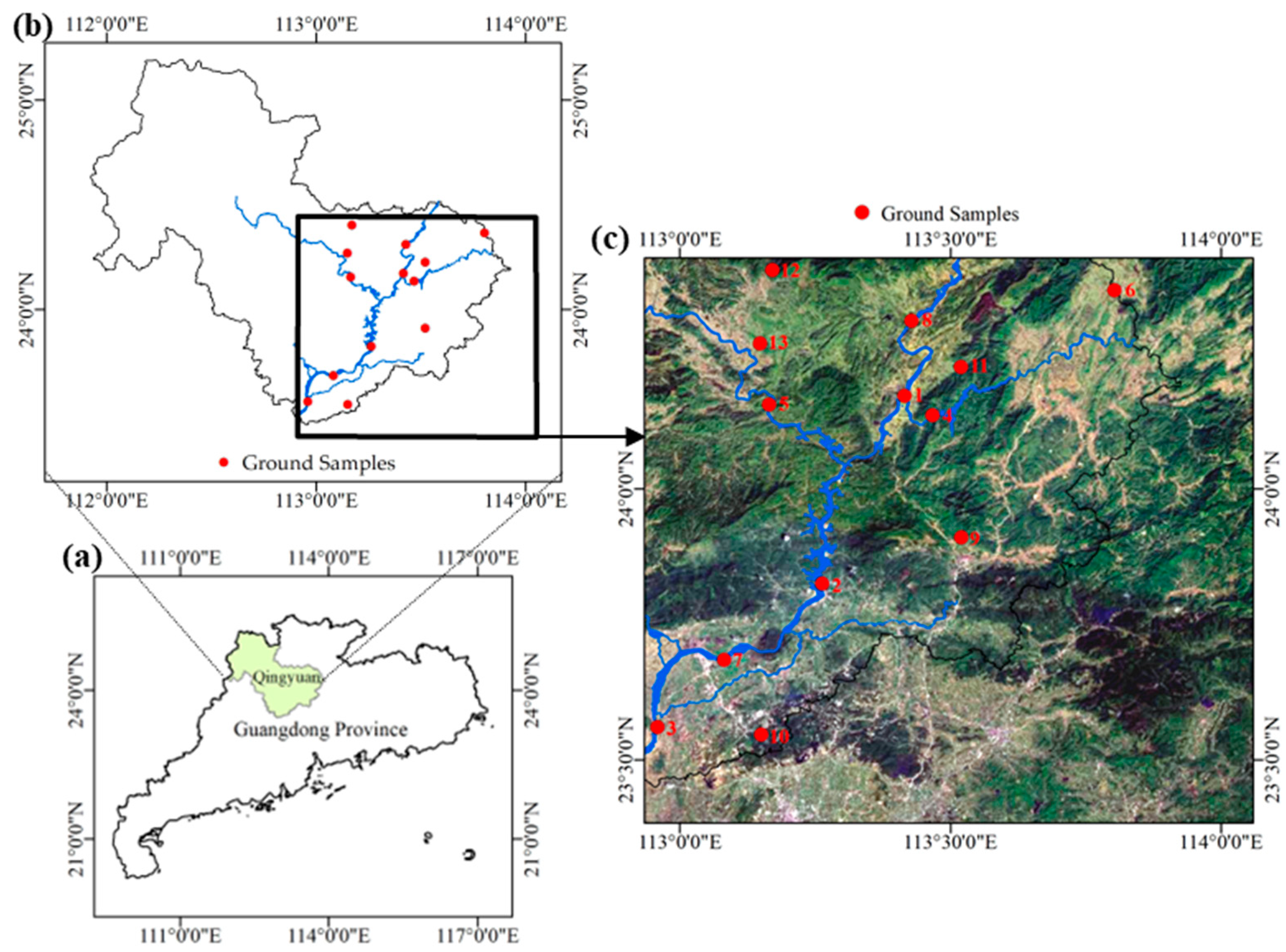
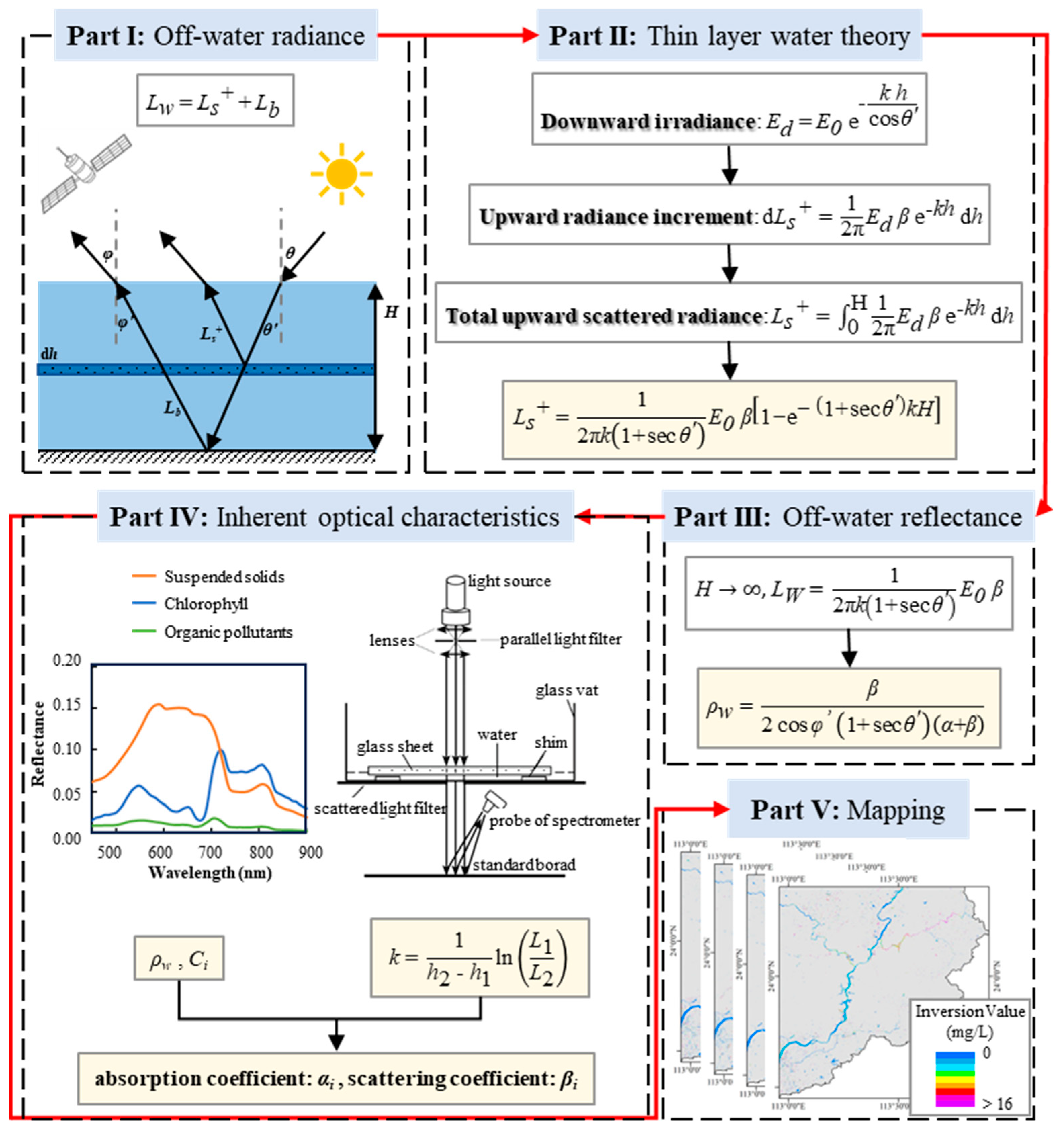
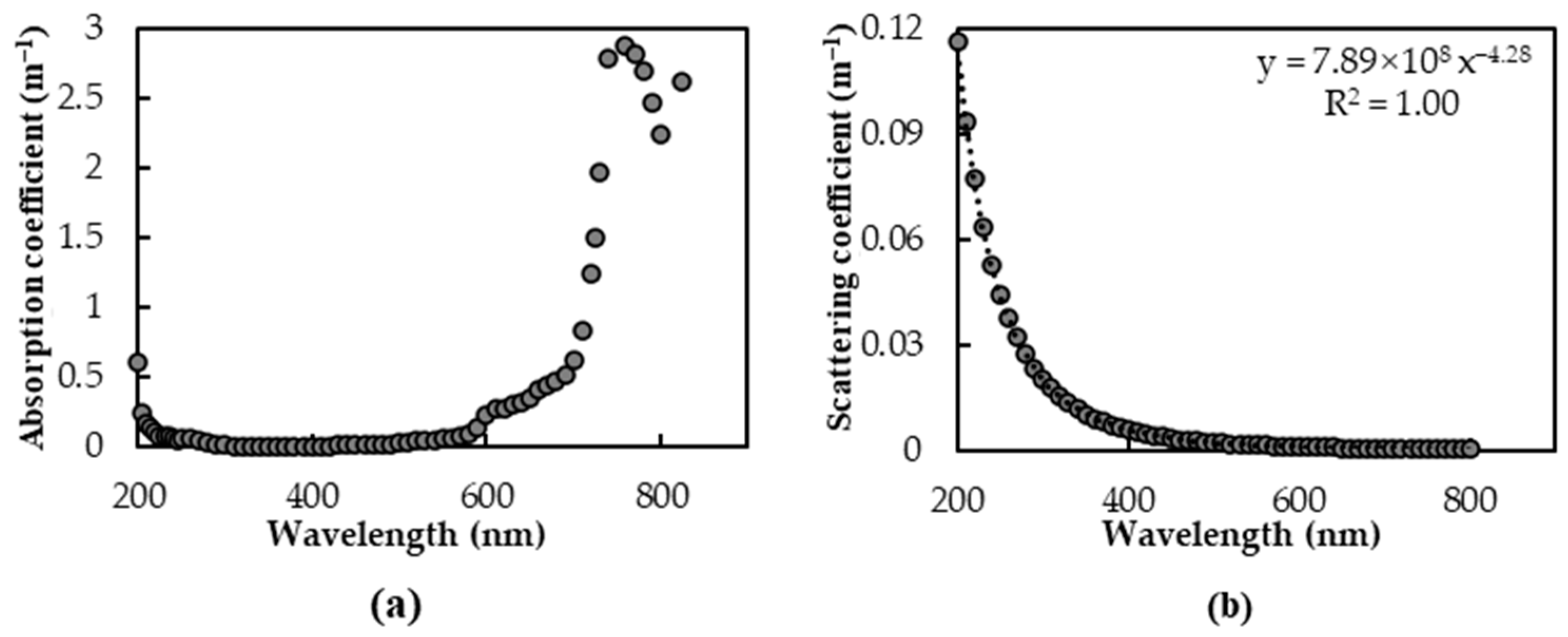

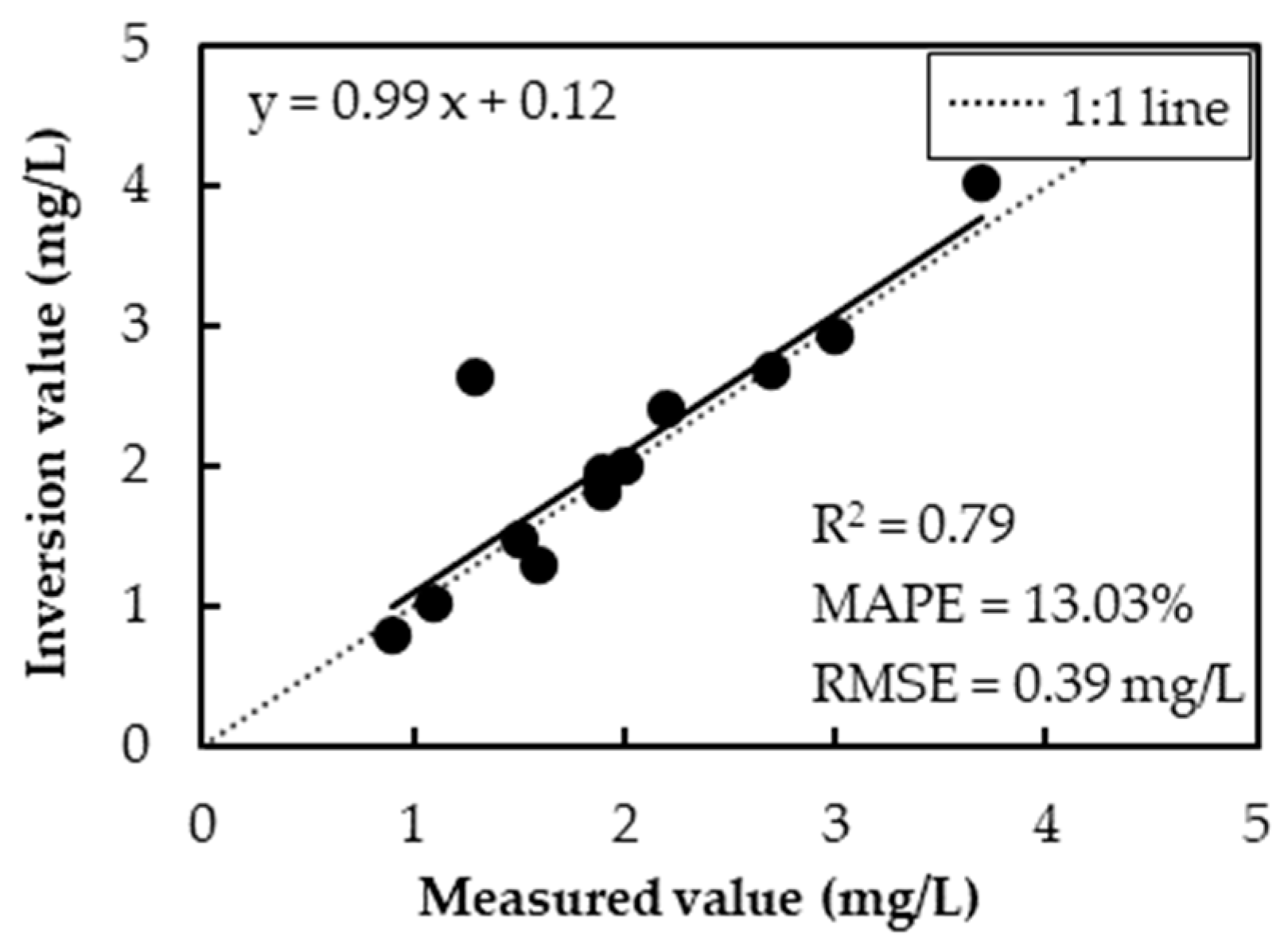
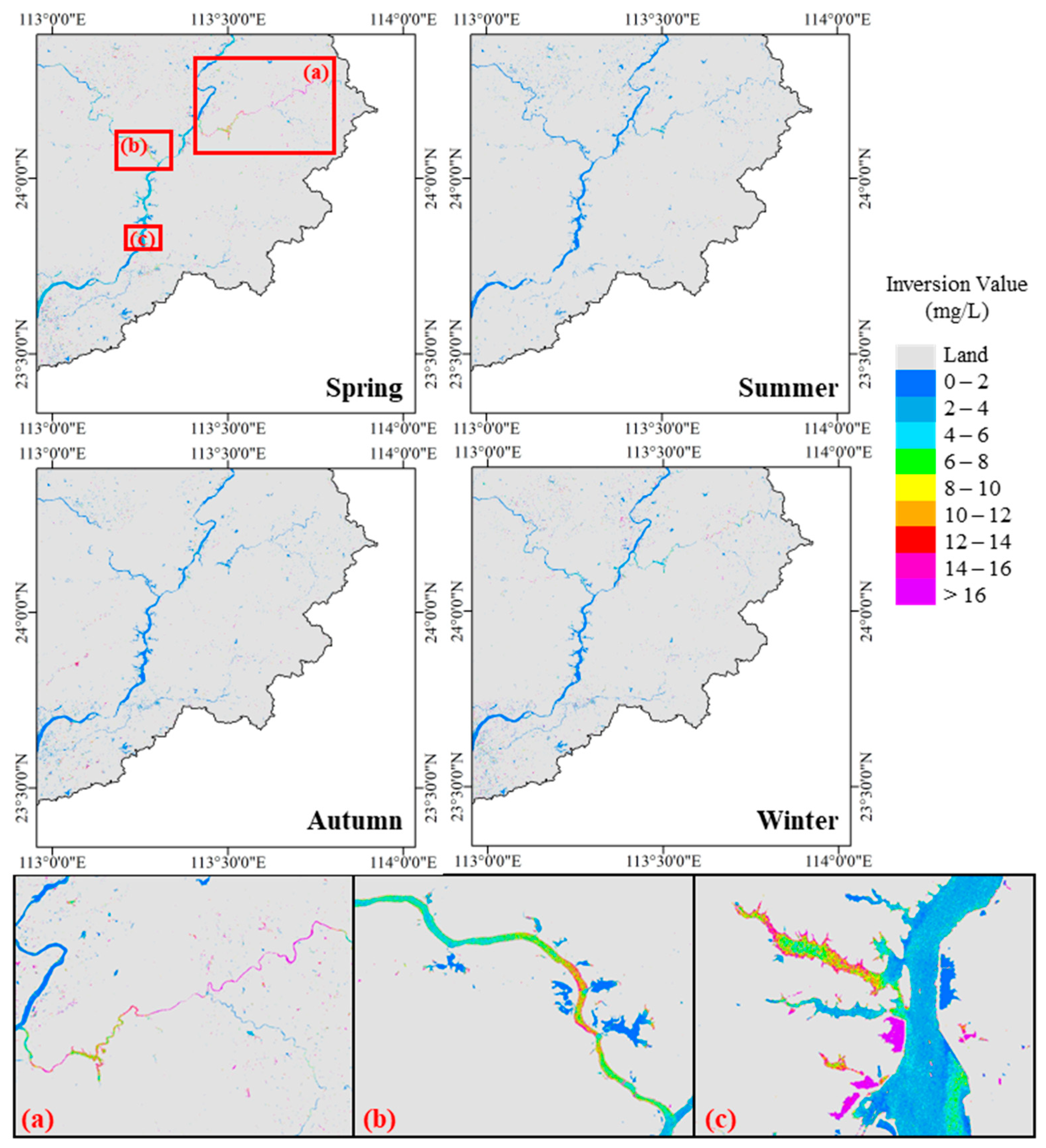
| Band Number | Central Wavelength (nm) | Bandwidth (nm) | Spatial Resolution (m) |
|---|---|---|---|
| 1 | 443 | 20 | 60 |
| 2 | 490 | 65 | 10 |
| 3 | 560 | 35 | 10 |
| 4 | 665 | 30 | 10 |
| 5 | 705 | 15 | 20 |
| 6 | 740 | 15 | 20 |
| 7 | 783 | 20 | 20 |
| 8 | 842 | 115 | 10 |
| 8b | 865 | 20 | 20 |
| 9 | 945 | 20 | 60 |
| 10 | 1375 | 30 | 60 |
| 11 | 1610 | 90 | 20 |
| 12 | 2190 | 180 | 20 |
| No. | Measured Value (mg/L) | Inversion Value (mg/L) | RE |
|---|---|---|---|
| 1 | 1.5 | 1.471 | 0.02 |
| 2 | 1.6 | 1.303 | 0.19 |
| 3 | 1.9 | 1.811 | 0.05 |
| 4 | 3.7 | 4.020 | 0.09 |
| 5 | 3.0 | 2.921 | 0.03 |
| 6 | 2.2 | 2.418 | 0.10 |
| 7 | 1.9 | 1.897 | 0.00 |
| 8 | 2.0 | 1.994 | 0.00 |
| 9 | 1.3 | 2.625 | 1.02 |
| 10 | 1.1 | 1.031 | 0.06 |
| 11 | 1.9 | 1.952 | 0.03 |
| 12 | 2.7 | 2.682 | 0.01 |
| 13 | 0.9 | 0.801 | 0.11 |
| Min | 0.9 | 0.801 | 0.00 |
| Max | 3.7 | 4.020 | 1.02 |
| Average | 2.0 | 2.071 | 0.13 |
Disclaimer/Publisher’s Note: The statements, opinions and data contained in all publications are solely those of the individual author(s) and contributor(s) and not of MDPI and/or the editor(s). MDPI and/or the editor(s) disclaim responsibility for any injury to people or property resulting from any ideas, methods, instructions or products referred to in the content. |
© 2025 by the authors. Licensee MDPI, Basel, Switzerland. This article is an open access article distributed under the terms and conditions of the Creative Commons Attribution (CC BY) license (https://creativecommons.org/licenses/by/4.0/).
Share and Cite
Li, J.; Deng, R.; Guo, Y.; Lei, C.; Hua, Z.; Yang, J. Quantitative Estimation of Organic Pollution in Inland Water Using Sentinel-2 Multispectral Imager. Sensors 2025, 25, 2737. https://doi.org/10.3390/s25092737
Li J, Deng R, Guo Y, Lei C, Hua Z, Yang J. Quantitative Estimation of Organic Pollution in Inland Water Using Sentinel-2 Multispectral Imager. Sensors. 2025; 25(9):2737. https://doi.org/10.3390/s25092737
Chicago/Turabian StyleLi, Jiayi, Ruru Deng, Yu Guo, Cong Lei, Zhenqun Hua, and Junying Yang. 2025. "Quantitative Estimation of Organic Pollution in Inland Water Using Sentinel-2 Multispectral Imager" Sensors 25, no. 9: 2737. https://doi.org/10.3390/s25092737
APA StyleLi, J., Deng, R., Guo, Y., Lei, C., Hua, Z., & Yang, J. (2025). Quantitative Estimation of Organic Pollution in Inland Water Using Sentinel-2 Multispectral Imager. Sensors, 25(9), 2737. https://doi.org/10.3390/s25092737






